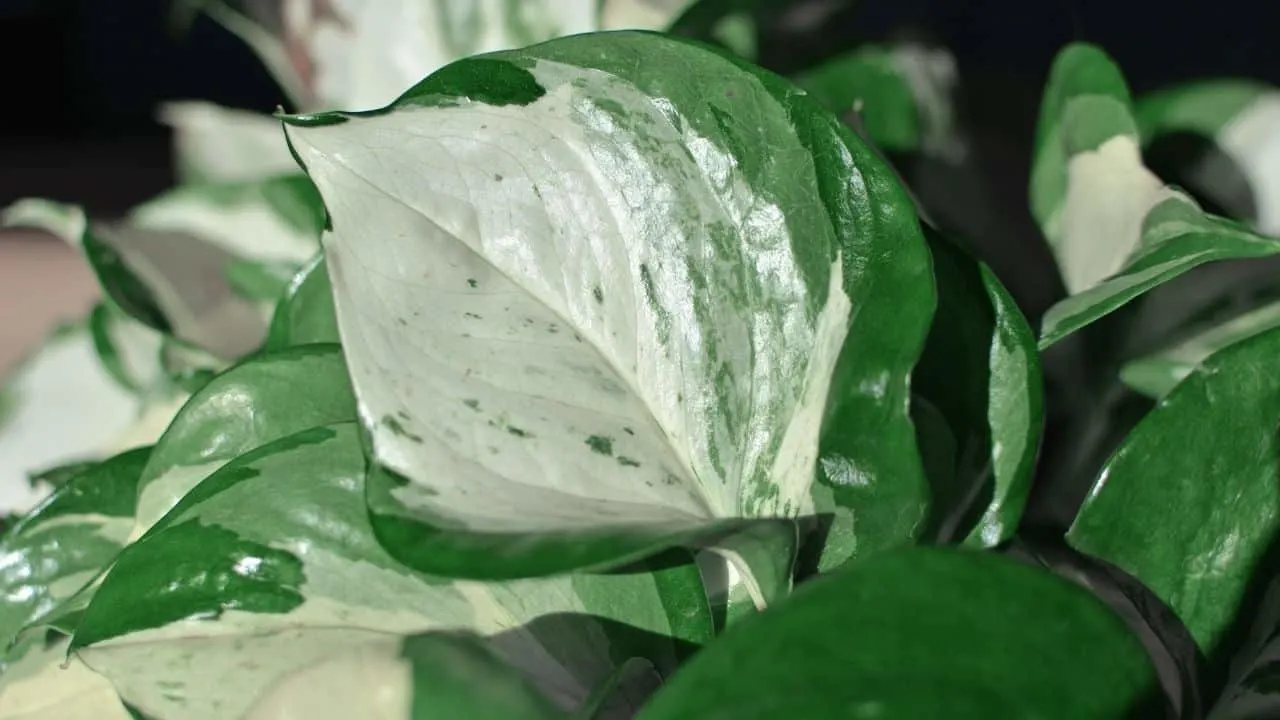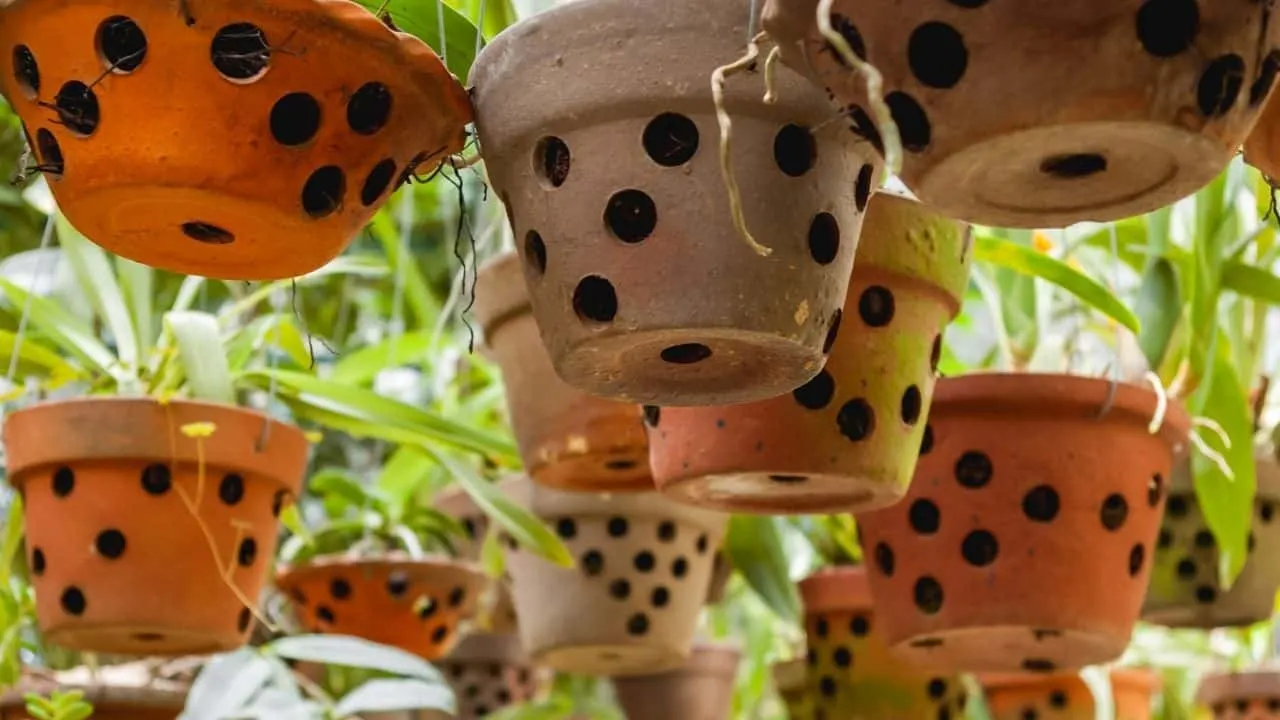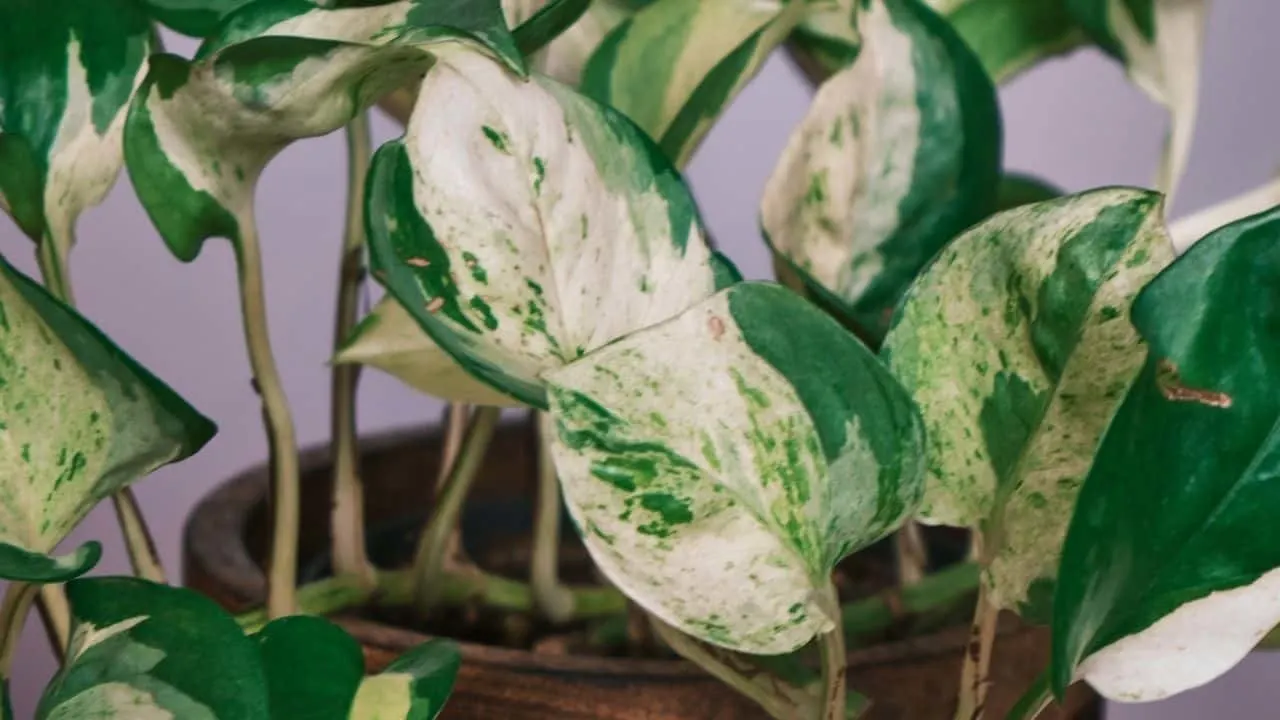Epipremnum aureum Manjula is also called the Manjula pothos or happy leaf.
Pothos has wavy edges on its leaves, one of the key characteristics differentiating it from its siblings.
This plant has green leaves shaped like a heart and are adorned with white, cream, and silver variegation.
University of Florida researchers developed a new variety of Pothos plants (Epipremnum aureum) called Manjula Pothos.
The plant is from the Araceae family and has similarities to the Pearls and Jade Pothos. Manjula, like other varieties of Pothos, is native to the Pacific island and Asia.
Finally, Manjula Pothos plants can brighten up indoor offices, sheds, and outdoor working areas.
According to NASA, Manjula removes air pollutants. Therefore, you will breathe cleaner air and live in a healthier setting.
Table of Contents
Manjula Pothos Care
Manjula Pothos does best in areas that receive lots of bright, indirect sunlight. The ideal temperature is 64-84°F (18-29°C). They can survive in temperatures that are as low as 43°F (6°C) without damage and as hot as 104°F (40°C) with shade. The Manjula requires frequent watering about once a week and loamy, well-draining potting soil using orchid bark, coco coir, and perlite. The soil pH should be neutral (6 – 6.5). Fertilize every 2-4 weeks in summer and spring using a balanced fertilizer with an NPK of 10-10-10.
Manjula Pothos Care Guide
Soil
For Manjula Pothos care, choose soil that has excellent drainage yet retains water well. By doing so, your Pothos will have access to moisture but will not be sat in excessive water.
Like all Pothos, Manjula prefers potting soil that is loamy, light, well-draining, and neutral in pH (6 – 6.5).
Whether you are building a terrarium or a houseplant, I would recommend orchid bark, coco coir, and perlite.
Furthermore, this will ensure sufficient root aeration for your plant.
Light
You need not fret about an awkward window for the Manjula Pothos care, as it can survive most light conditions.
Indirect light, however, is better than direct sunlight. Even though it can handle the heat, direct sunlight can scorch the leaves, so keep it out of the blazing sun.
Due to the white leaves, the plant must receive indirect but very bright light to photosynthesize.

Creamy White Leaf Colors of the Manjula Pothos
In dim lighting, your variegated leaves may lose some of their creamy-white colors. In the absence of enough natural light, place it under a grow light instead.
Watering
Manjula Pothos care only requires watering every 2-3 weeks, and even when it does, only a little water is needed at a time.
You can determine exactly how much water it needs by touching it with your finger. If it looks dry on top, but damp underneath, water it lightly.
Wait another week to water the soil if the top’s wet.
To avoid excessive moisture in the soil, keep the plant in a pot with a drainage hole. Drainage holes contribute to preventing root rot and pooling of excess water at the pot’s bottom.

Pots with drainage holes
Unlike other varieties of Pothos, this one is not particularly drought tolerant, so I wouldn’t let it stay in dry soil for very long.
Temperature
The ideal temperature for Manjula pothos is 64-84°F (18-29°C).
I have never come across a tropical plant more resistant to extreme temperatures than the Manjula Pothos.
It has been recorded that she can withstand temperatures as low as 43°F (6°C) and as hot as 104°F (40°C) with shade.
Humidity
Manjula like high humidity just as much as all Pothos plants, so if you still need more reasons to put them in a terrarium, here is one!
Manjula Pothos grows best in Mumbai and Florida; therefore, she will enjoy anything between the 60-90% range.
Fertilizer
Manjula pothos care doesn’t require special plant food. Any balance houseplant fertilizer should do just fine for it: therefore, I recommend using an NPK of 10-10-10.
Make sure it’s getting enough nitrogen since it is a foliage plant. Nitrogen stimulates plant growth, leading to better-looking foliage.
However, the plant will not die without fertilizer, but nutrients will help it grow better and fuller.
Most importantly, feed it only during the growing season (spring and summer) and not during the winter months.
For best results, provide it every 2-4 weeks in summer and spring.
Propagation
Stem cuttings are the best (and easiest) method for propagating Manjula pothos. It’s best to propagate your Manjula pothos when it’s pruned.
After all, trimming produces stem cuttings; therefore, it’s a good idea to take advantage of the chance to do two things simultaneously.
Early spring or summer are ideal times for propagating plants so that they can immediately begin growing.
You can expect it to take approximately 20 days during the summer and up to 40 days during the winter (if your area is cold), along with good Manjula Pothos care.
As soon as it has nice root growth, plant it, name it, marvel at it, and place it with other plants to make new friends.
Growth
With proper Manjula Pothos care, vines can reach heights of 20′ to 40′ when grown outdoors in a tropical environment.
Plants grown in a container require regular trimming, pruning, and pinching to control their growth.

Manjula Pothos in a Container requires Regular Trimming
Because of its silver, cream, and white variegation, Manjula tends to grow slowly. A leaf with less chlorophyll has less food available for faster growth.
Potting
Pothos are slow growers; however, they can become rootbound over time and require repotting.
Furthermore, the nursery pot may already be too tight when you purchase a new Manjula plant.
Check to ensure the roots do not extend above the soil line or through the container’s drainage holes.
Following the steps below will help you pot your plant correctly and provide special Manjula Pothos care:
- Look for a container that is one size bigger than the current one.
- Make sure the container has sufficient drainage holes.
- Ensure the pH level of the potting soil is between 6 and 6.5.
- Ideally, the homemade potting mix contains 1 part of perlite and 2 peat moss parts.
- Take the plant out from its old container and detangle its roots gently.
- Place the root ball in its newest container and add some fresh soil.
- Provide the plant with adequate water and place it in bright light.
Pruning
Pruning is essential for Manjula Pothos care. Manjula is slow-growing, but they require pruning to remove damaged foliage and maintain their bushy shape.
In order for the plant to regrow quickly after pruning, it needs to be done in the growing season, mainly in summer or spring.
- Select where you’d prune each vine.
- Always cut the vine 14 inches (about 2/3 cm.) above each leaf.
- After you prune your pothos, a new vine will grow in the node where the leaf meets the vine. Avoid leaving leafless vines behind. I find that these won’t grow back and would recommend pruning them entirely off.
- Continue pruning each vine selectively until you’re okay with the results.
- You can make light pruning by just taking tips off of vines that are too long.
Toxicity
There is some mild toxicity associated with Manjula Pothos plants, both for humans and animals.
It is wise to steer the plant clear from the reach of curious kids and furry friends.
Step-by-Step Propagation of the Manjula Pothos
By Stem Cutting
- Pour bottled water into the container.
- Pick a healthy vine with at least five leaves.
- Remove the vine by snipping it close to the base of the plant using sterilized scissors.
- Cut off the leaves and leaf nodes along the vine.
- Submerge the cuttings in fresh water for a week or two till roots develop.
- Plant the cuttings in the soil after they have grown 1-2 inches in fresh soil.
By Division
- Remove the Manjula pothos from its pot or container.
- With a sterilized knife, cut the stems into equal portions.
- When splitting the plant, make sure that the root ball is divided evenly between the stems.
- Place each section in fresh soil, then thoroughly water it.
Common Problems with Manjula Pothos
Mealybugs
Mealybugs attack various plants, both indoors and out. I incredibly despise that that they almost always cause infestations.
If the room is humid and warm, there is a high probability of these insects appearing.
You can find them feeding on and sucking the sap from the pothos stems. You can spray insecticidal soap and water on these pests and get rid of them.
Botrytis
Many people don’t know this, but Botrytis is an occurrence of gray mold that appears on indoor plants.
Your Manjula Pothos can be infected with this fungus if you grow them indoors. In addition to damaging plants, some people may also experience allergic reactions due to Botrytis.
This problem can only be treated by cutting off the plant’s infected portions.
Always disinfect your pruners between cuts with a 10% household bleach solution to prevent the spread of the disease.
Spider Mites
Spider mites build webs near the base of leaves where they join the stem. They can ruin your Manjula pothos care and kill plants by sucking their juice and sap.
Since spider mites prefer dry environments, they appear when there is low humidity.
To get rid of them, mist the plant to increase humidity. You can spray water around the bottom and ends of the leaves after you remove the pests.
Spray the affected area by mixing a drop of dish soap and water in case of infestation. Spray it directly onto leaves and pests, let it dry overnight, and wash it off the next day.
Your pothos gets killed if you leave the soap too long.
Sparse Leaves
In some cases, the plant stops growing. In this case, the affected stems can be cut all the way down to the soil to restart your plant’s growth.
After some time, new stems will appear if you take proper Manjula Pothos care.
Root Rot
Brown leaves are usually the result of exposure to direct sunlight. Otherwise, the roots of your plant may be rotting.
For Manjula Pothos care, simply remove the pot, trim its roots, and add fresh soil when repotting it.
Tips to Keep Manjula Pothos Problem-Free
Follow these tips for proper Manjula Pothos care:
- Keep your Happy Leaf in indirect but very bright light.
- Once the topsoil feels dry, water it.
- Never overwater it, or else the roots will rot.
- Propagate and fertilize in the growing season, i.e., spring or summer.
- Ensure the pot’s got sufficient draining holes.
Read more in my full Pothos growing guide.
Frequently Asked Questions about Manjula Pothos
How Long Does It Take Manjula Pothos To Root in Water?
Root formation can take up to 7 to 14 days, depending on temperature and light conditions.
Why is my Manjula turning yellow?
Yellow leaves are typically a sign of root rot, though there are other causes as well. Make sure your terrarium or pot has adequate drainage. Also, let it dry out between waterings.
How often should I repot my pothos?
It is likewise an excellent time to repot your Manjula pothos in spring or summer. However, you won’t need to do this until the plant outgrows its current container, probably after 2 years.
Can I cut off the brown leaves of my Manjula Pothos?
If the leaves are more than 50 percent damaged, remove the leaves immediately. The remaining healthy foliage receives more nutrients, which subsequently improves its appearance.
Why is my Manjula Pothos turning green?
Probably your Manjula doesn’t get enough light and requires more green leaves to photosynthesize! You can try growing under a grow light or moving it to a brighter area.
Conclusion
There have been several new varieties of Pothos recently, all with beautiful leaf variegation, making this plant one of the trendiest on the market.
The slow-growing, easy-going Manjula Pothos care makes it the perfect focal point for any indoor décor.
Manjula Pothos is not only beautiful and carefree, but it also works as an excellent air purifier, removing toxins and pollutants from our homes.
These practical tips are essential for Manjula Pothos care and keep your plant trailing lazily around your home, even when you forget to water it.

Daniel has been a plant enthusiast for over 20 years. He owns hundreds of houseplants and prepares for the chili growing seasons yearly with great anticipation. His favorite plants are plant species in the Araceae family, such as Monstera, Philodendron, and Anthurium. He also loves gardening and is growing hot peppers, tomatoes, and many more vegetables.


